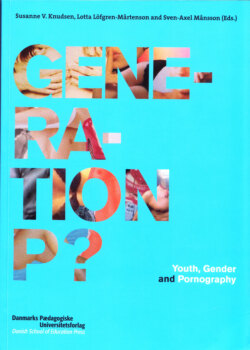Читать книгу Generation P? - Группа авторов - Страница 13
На сайте Литреса книга снята с продажи.
The self-directed gaze and self-discipline
ОглавлениеThe advertising industry’s construction of gender is not only related to mass culture’s general porn chic tendencies, but is also concurrent with an era where local business organisations all over Denmark are arranging ‘wannabee’ and ‘lookalike’ competitions in the commercial centres of towns. In the middle of a Saturday’sshopping hell you can find rest in front of a stage where little girls with edgy hips try to copy the latest music videos of Kylie Minogue or Britney Spears. Although it might be advertised differently, the competition on the stage in the town centre is not about dancing and pop idols, but about the girls’ ability to act like mature women. It is about copying women’s attitudes and transmitting the same sex appeal to the public in the same way as women with sexual experience can do it. If the girls do not succeed at the town centre, there are lots of other competitions they may enter. Both Danish national TV channels have ’auditions’ that are transmitted nationally. And in the Christmas Catalogue from Magasin (a shopping centre in Copenhagen) in 2001 girls between 4 and 12 years could win a “princess day”, which consisted of first being styled like a princess at Estée Lauder Skincare Centre, then having breakfast in Magasin’s Café, riding a limousine around in Copenhagen, and finally watching the ballet in the Tivoli’s Concert Hall. In Magasin’s logic the girls experience the world by being seen by the world. The self-directed gaze and the self-discipline that automatically follow are being activated early for little girls.
One possible objection could go like this: Why would boys’ and girls’ conception of gender be affected by what mass culture exposes them to? The answer must be that when the gender representations that mass culture offers become increasingly one-dimensional in their portrayal of feminine and masculine sexuality, the role models from whom boys and girls can select fragments of identity become fewer. From media research we have learnt that there is a relation between reality and the descriptions mass culture reports. Real life does influence illustrations and narratives. However, influence also goes in opposite direction. Real life is shaped by the illustrations mass culture produces. Hence, the illustrations are not only a reflection of reality, but a co-producer of it. Recent observations in Denmark of primary school girls indicate that their experiences while growing up teach them to be painfully aware of not appearing ‘cheap’ (Görlich & Kirkegaard 2000). After adopting the sexualised expressions of femininity in order to be recognized as ‘female’ they must then, every day, walk the fine line between the whore/Madonna dichotomy, and in order to be able to navigate in this grey zone they need to carefully use the self-directed gaze that mass media have equipped them with since early childhood.
